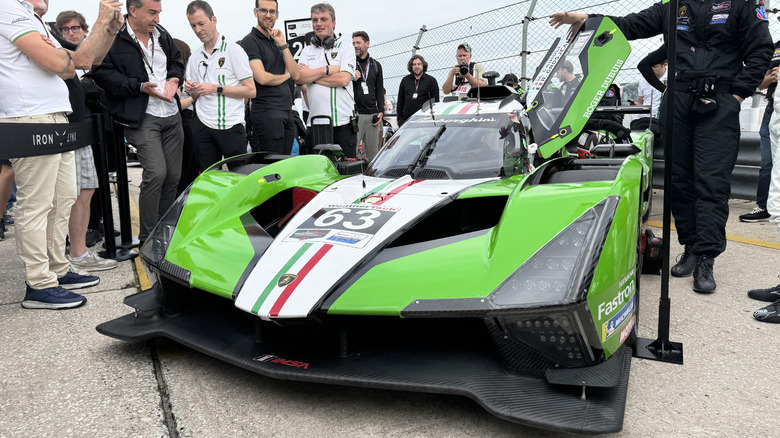
Michael Teo Van Runkle/SlashGear
This year the 12 Hours of Sebring marked the first appearance of Lamborghini’s new SC63 hypercar on American soil. Though a few design cues on the radically aerodynamic prototype body identify the racecar as a Lambo, just as the other new LMDh cars that debuted from BMW, Acura, Cadillac, Porsche, and Alpine over the past 18 months, the SC63 is without a doubt a purpose-built racer with very little relation to any of the Italian automaker’s iconic roadgoing models.
In fact, founder Ferruccio Lamborghini long instilled his company with the belief that it never needed to go racing to prove anything in competition against other automakers. Yet here in 2024, Lamborghini can now celebrate an inaugural year of prototype racing along with 15 years of success for the Huracan GT3 racecar. I attended Sebring for the first time, as well, hoping to learn more about how the SC63 can help Lamborghini in the transition to hybridization and electrification of roadgoing supercars (and SUVs!) while immersing myself in the unique Central Florida culture of one of the world’s premier endurance races.
Working with a short development timeline
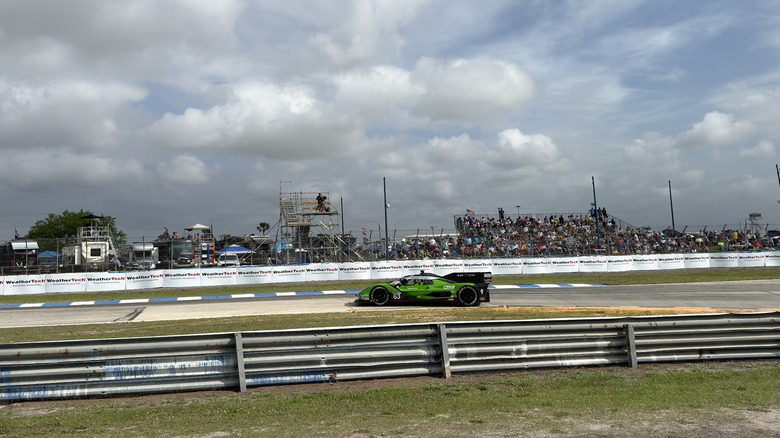
Michael Teo Van Runkle/SlashGear
Lamborghini began working on the SC63 in 2022 with the aim of competing in the 2024 World Endurance Championship and IMSA seasons. The new LMDh class, which combines Le Mans and Daytona prototype regulations, simply proved too tempting. But most other teams in the hunt this year debuted racecars all the way back at the 24 Hours of Daytona in 2023, providing far more testing opportunities to collect data than Lamborghini’s accelerated timeline.
At Sebring, Lambo Chief Technical Officer Rouven Mohr took over management of the endurance racing effort when long-tenured head of motorsports Giorgio Sanna abruptly resigned earlier this month. And Mohr admitted before the race even started that both the team, and himself, could use a bit more time to prepare for such a challenging season, which began with a difficult race in Qatar. Throw in a crash during testing last August, the extensive FIA homologation process, and now Sebring’s chopped-up surface as additional challenges, and the Lamborghini effort–managed by Iron Lynx Racing Team–seemed left a little in the lurch.
«Unfortunately, we are suffering a little bit in this situation,» Mohr told me. «But to be honest, it’s not a surprise. Since we had the rollout last year, in August we had the unfortunate crash where we were more or less out of the car for one month… Since then, we were not so much testing, but focused more on functionality of the car, that the car runs.»
12 hours of racing at Sebring provide extra challenges
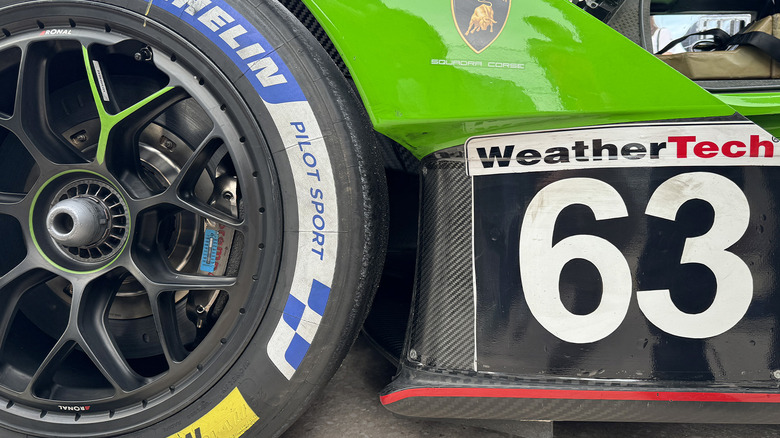
Michael Teo Van Runkle/SlashGear
The days leading up to Sebring allowed Mohr to oversee three free practice sessions, though the last was only a night run to check the SC63’s lighting system. But even during the first few laps once the race began, I noticed with my own eyes how much every car bumped and bounced over the crackling Sebring surface—just another challenge for a team already playing catch-up.
Fans of Formula 1 might remember Lewis Hamilton’s struggles with his Mercedes car «porpoising» in 2022 and 2023, but Sebring leaves every team in a similar situation. For an LMDh car that relies on aerodynamic performance almost more than power delivery, those bumps interfere with air flowing over and under the car, causing enormous headaches to find the ideal balance between suspension and aero setups. After speaking with Mohr, I watched as cars caught air leaving Turn 1, skittering around Turns 10 and 11 with almost no traction. Not ideal, to say the least, and the SC63 seemed to suffer from the issue more than most.
Luckily, Mohr at least seemed confident in the drivetrain’s ability to survive through a 12-hour race, despite the fact that Lambo built the twin-turbocharged 3.8-liter V8 to pair with a Bosch hybrid-electric system entirely from scratch.
A delicate combo of aero, power, and suspension
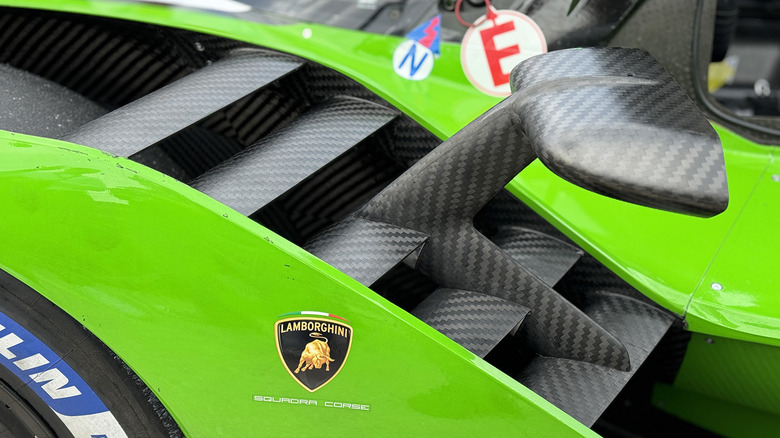
Michael Teo Van Runkle/SlashGear
«The engine is truly all-new, there was a white sheet of paper and there’s not any component, not any dimension that is carried over from an existing Lamborghini engine,» Mohr explained. «For this kind of racecar, you need a very dedicated setup for the engine because the engine is more or less defining, a little bit, the aero concept. And vice versa, the aero concept is also defining part of the engine packaging. And therefore, for us, it was absolutely fundamental that we didn’t make a compromise, even if the maximum power output is limited based on the regulations.»
The LMDh class limits power output to 680 PS (671 horsepower) by measuring torque output via sensors at the axles. But if Lamborghini lowered and firmed up the suspension enough to optimize the SC63’s downforce, the team risked a wheel lifting off the ground and spinning up too quickly, which might cause temporary torque measurements to jump above the allowed figures.
The SC63 needs more mileage and time to refine
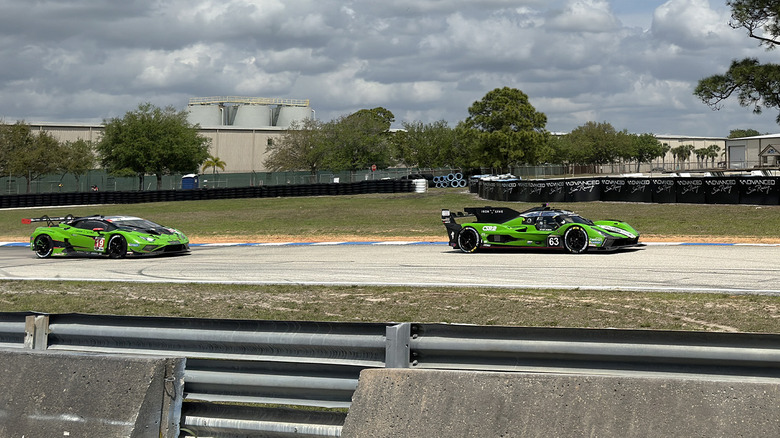
Michael Teo Van Runkle/SlashGear
But with only a single car running during essentially two practice sessions, Mohr simply needed more time and data to dial in the setup properly. I asked him whether Lamborghini’s selection of Ligier as the SC63’s chassis builder—as opposed to every other team running a monocoque built by Multimatic, Dallara, and Oreca—might have helped or hindered the last-minute effort to optimize the interplay between damping, ride height, and aerodynamics.
«From the beginning on, we had a good feeling about the Ligier collaboration because this is also a smaller company, like us,» Mohr said. «They proved that they have a good know-how on these things. And from our point of view, it was an advantage that we are the only LMDh manufacturer with this chassis partner.»
Ligier sent reps to Sebring and Mohr stayed in contact with them throughout the weekend, but reacting to the conditions seemed to lend the effort more of an experimentation kind of ethos rather than a confident capability to manage the situation. And Mohr admitted that given the quick ramp-up, the challenging nature of Sebring, and his own newfound position, Lamborghini arrived to this first race in the United States harboring minimal hopes of notching the SC63’s first win.
Drivers can dial in settings on the fly
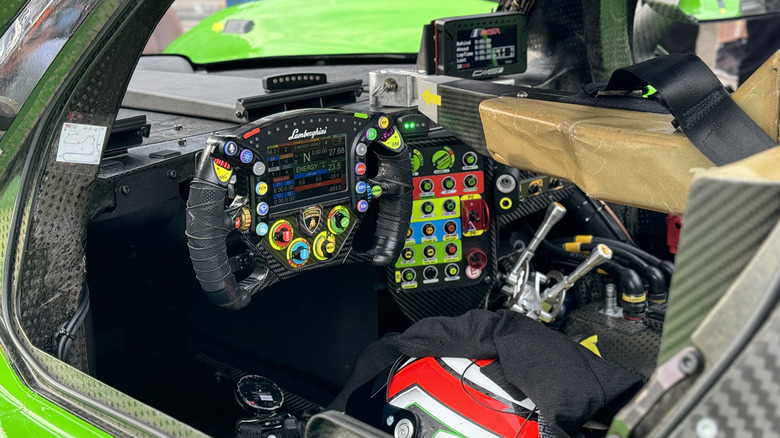
Michael Teo Van Runkle/SlashGear
Throughout the first few hours of racing, that prediction certainly seemed to hold true. The Lambo sat in dead last place among the LMDh cars, shedding time especially after every pit stop and safety car. But Mohr pointed out that the SC63’s fastest lap times nonetheless managed to come within a second of the leading Cadillac’s best time. When I asked why, he explained that the tires needed too much time to warm up, leading to four or five seconds lost per lap for four or five laps after each stop or cooldown. Again, this came down to the suspension and aero not quite maximizing tire traction enough.
Similar to a roadgoing Lamborghini like the epic Huracan Sterrato, however, the SC63 allows the driver to fiddle with suspension, power delivery, and traction control settings on the fly. I asked Mohr how much the drivers themselves—former Formula 1 driver Romain Grosjean, Matteo Cairoli, and Andrea Caldarelli—can help to dial in the car during their stints.
«Really, I think the majority of the people don’t really understand how much adjustment possibilities we have in a racecar like this,» Mohr replied. «So a driver today is not only someone that is turning the wheel, braking hard, and going through the corner fast. They really have to understand, also, the technical knowledge for this generation of racecars.»
«There are some limits from the regulation point of view, but within these limits, you can control a lot of things: you have different recuperation maps, you have different traction control settings, you have even an adjustment of the roll bars.»
Racing informs road cars, and vice-versa
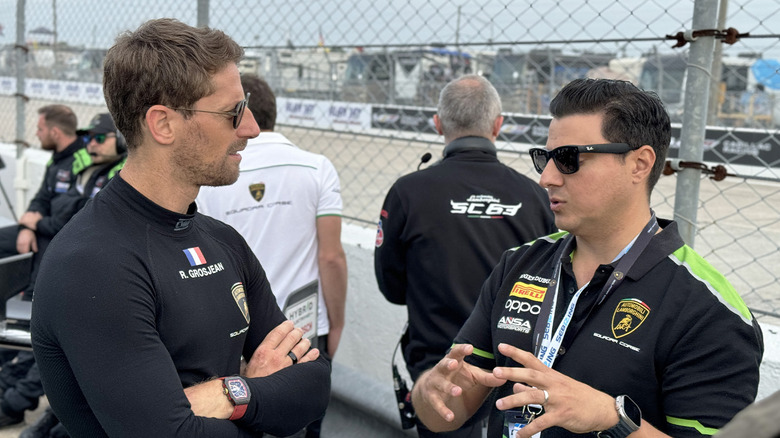
Michael Teo Van Runkle/SlashGear
Given the complexity of fiddling with those settings while driving at top speed throughout a 12-hour endurance race, I also wondered aloud whether the SC63 benefits at all from Mohr’s experience working on the 1,000-horsepower Revuelto hybrid or the forthcoming hybrid Urus, which I knew he recently took out for some winter testing. Mohr nodded in agreement, pointing to the modulation between the internal-combustion twin-turbo V8 and Bosch’s hybrid system, which he thinks made the car much more easy for the drivers to manage.
«The tough job here is not so much to manage the peak power,» he explained, echoing earlier comments in which he dismissed pure speed as the lazy EV-maker’s metric. «For sure, like in the street car also, drivability is fundamental. Going off throttle, going on throttle, transient response of the engine, this is something you have to work on a lot.»
Road car versus race car
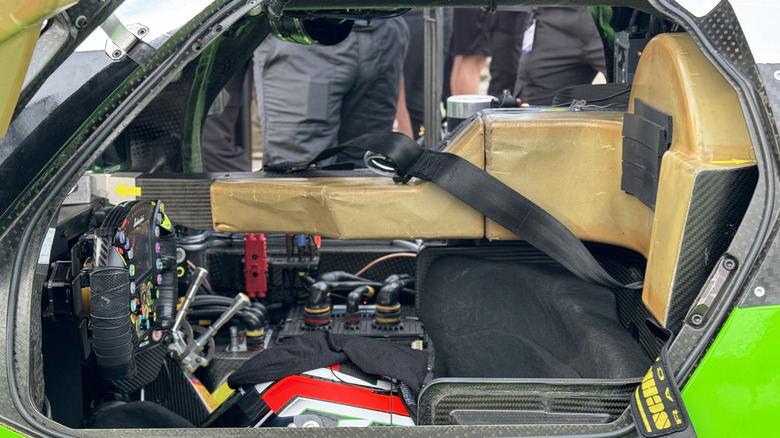
Michael Teo Van Runkle/SlashGear
I recalled driving the Revuelto on track, which absolutely stunned me in corners as the electric motors provided incredible traction thanks to torque vectoring while braking. But when I asked whether any knowledge gleaned from working on the SC63, as opposed to the Huracan GT3 that originally started life as a road-going car all those years ago, might apply to future road-legal Lambos, Mohr paused for a minute to think. Sure, competition always helps a company adapt to time crunches and deadlines, but he mostly seemed surprised to learn a lot about reducing friction between individual parts in the suspension system.
«People always think a racecar is so complicated to build,» Mohr said. «Yes, a racecar, to be at the top of competition, is super detailed and every detail has to fit perfectly from the pure complexity point of view. But a road car is a different story because you have to take care of different drivers, different tires, different conditions.»
Then again, the conditions at Sebring continued to prove difficult for Lamborghini and the Iron Lynx team. The drivers arrived back to the pits looking gassed, likely from jouncing around in the racecar but I also spotted a pitstop where the team needed to work on fixing the car’s onboard hydration system—not ideal in the sweltering Florida heat and humidity.
Drama at the 12 Hours of Sebring
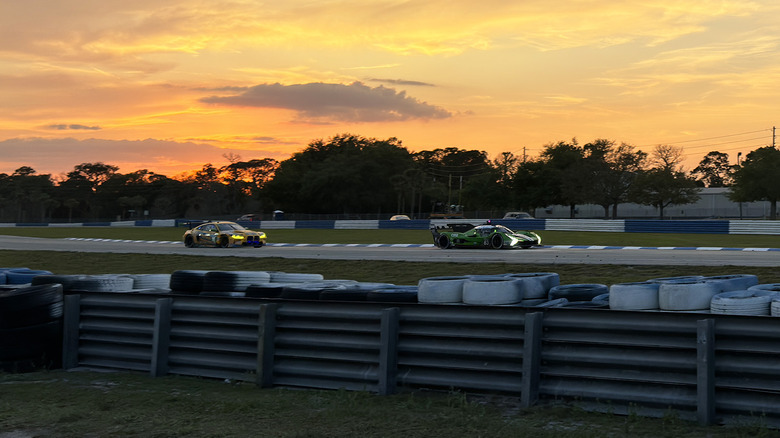
Michael Teo Van Runkle/SlashGear
As the temperatures dropped and the sun started to set, the mood within the Lambo team began to noticeably shift from frustration to optimism that the SC63 might actually finish the 12 Hours of Sebring. Knocking on wood, raised eyebrows, and nervous laughs notwithstanding, the clock ticked down steadily and darkness fell over the track. Still, the Lamborghini mostly languished behind the frontrunners, due again to time lost after pitstops and multiple safety cars.
The last few hours of racing proved quite dramatic. The leading Cadillac nicked a Ferrari while passing and flipped over onto a tire barrier, a Porsche needed a push getting back to the pits, and Acura’s second-to-last lap overtake sealed the win. Throughout, as I wandered the Sebring infield keeping an eye on the revelry—absolutely never partaking of the Fireball shots offered from spectators wearing wigs, and certainly not a single White Claw nor Coors heavy nor Corona—Lamborghini steadily climbed up the leaderboard. I kept an ear out for the awesome Ford Mustang GTD racers roaring past, and noticed how different the always-set-to-be-unusual Cadillacs sounded from the rest of the LMDh cars.
A solid finish, despite never competing for the win
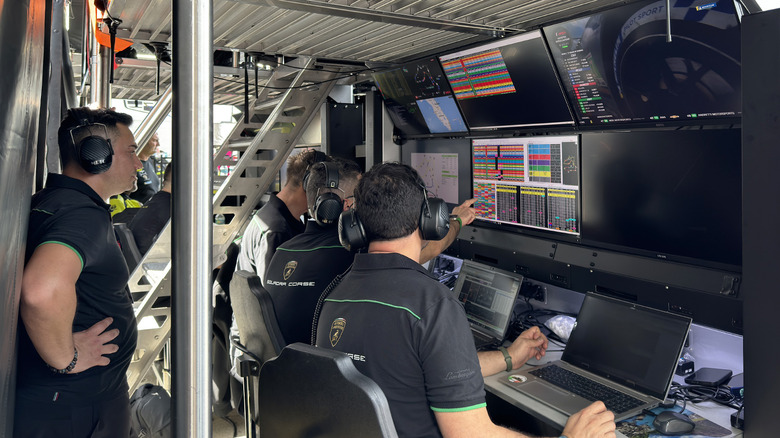
Michael Teo Van Runkle/SlashGear
Back with the team, a cheer erupted as the SC63 crossed the finish line in seventh place and on the same lap as the winning Acura. Talk about a big step up in performance from the Qatar outing, where the car finished in 15th and five laps off the winner’s pace. And arguably at a much more challenging track, which further highlighted the shortcomings in prep for a car entering only its second race.
But most importantly, for Mohr, the gap between the SC63’s fastest lap dropped all the way to 0.4 seconds compared to the laptime set by Acura. As the winners celebrated at Sebring’s podium and the crowd lit a traditional sofa on fire—welcome to Florida, kids—Lamborghini and the Iron Lynx team revealed a bit of relief, but mostly optimism about future appearances at Imola in Aprila and Watkins Glen over the summer.
«I still believe motorsport application is still super important for the emotional attachment of the brand,» Mohr said. «From the hybrid side, you learn a lot about the integration of the ICE engine and electric motor.»
The future of Lamborghini endurance racing
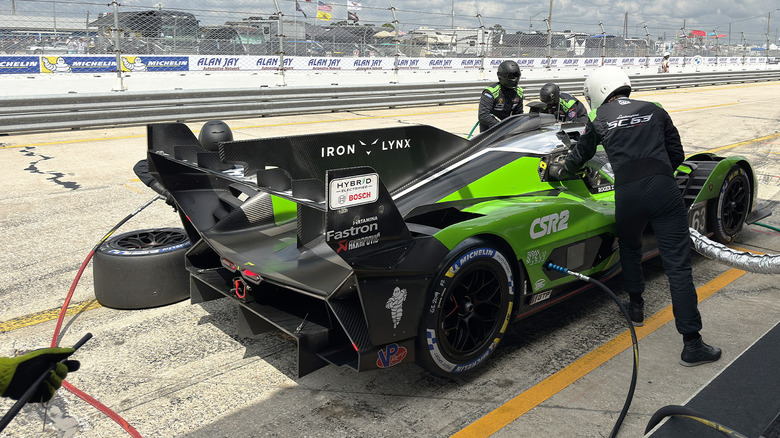
Michael Teo Van Runkle/SlashGear
For Lamborghini, the combination of internal combustion and electrification represents the future of customer cars, too. And even in the racecar, Mohr never wants the electric motor to drain the battery fully, becoming dead weight rather than providing additional output. Part of the goal of the LMDh program, as CEO Stephan Winkelmann further explained, involves opening customer eyes to the benefit of hybridization at the pinnacle of performance.
«The coupling of race technology is critical to help customers understand the future technology,» Winkelmann said. «A lot of other brands are engaging in this series, it is also important for a company of our size for engagement.»
From Mohr’s perspective, Sebring counts as a win even without a podium appearance. And he plans to add a second car by the start of next year’s season at Daytona, which will only increase the pace at which Lamborghini can play catch-up and, hopefully, start to truly compete in races from the starting lap.
«If you have three or four cars on the grid,» Mohr explained, «you’re collecting data at double or triple the rate, and you can test strategies much quicker.»
By that time, Mohr hopes to have found a new motorsports chief to manage the liaising between Lambo, WEC, and IMSA—though as CTO he will continue to oversee the SC63’s further refinement. Suffice to say, after getting tastes of endurance racing at Qatar and now Sebring, Lamborghini seems hooked. For customers and fans, that can only mean more performance from future models, though whether Lambo will ever offer a customer version of the SC63 remains a mystery that nobody at Sebring felt inclined to entirely rule out.